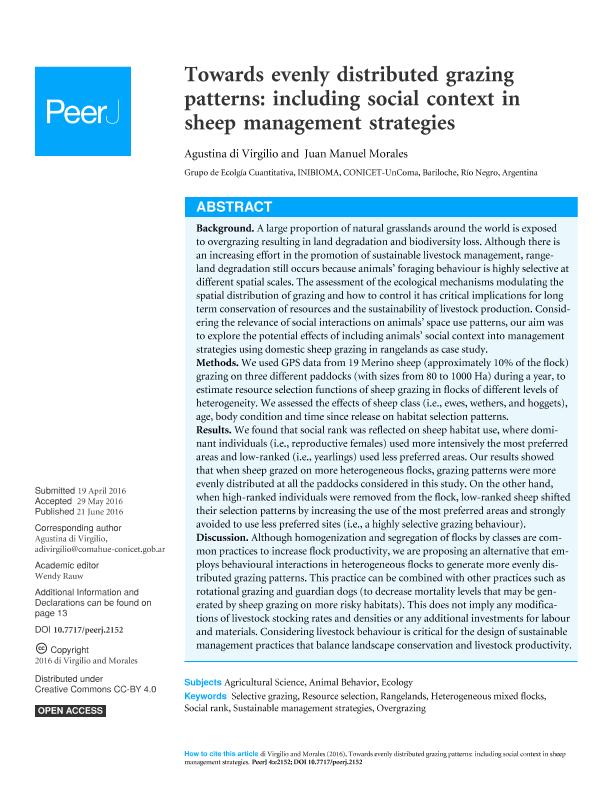Artículo
Towards evenly distributed grazing patterns: Including social context in sheep management strategies
Fecha de publicación:
21/06/2016
Editorial:
PeerJ
Revista:
PeerJ
ISSN:
2167-8359
Idioma:
Inglés
Tipo de recurso:
Artículo publicado
Clasificación temática:
Resumen
Background: A large proportion of natural grasslands around the world is exposed to overgrazing resulting in land degradation and biodiversity loss. Although there is an increasing effort in the promotion of sustainable livestock management, rangeland degradation still occurs because animals´ foraging behaviour is highly selective at different spatial scales. The assessment of the ecological mechanisms modulating the spatial distribution of grazing and how to control it has critical implications for long term conservation of resources and the sustainability of livestock production. Considering the relevance of social interactions on animals? space use patterns, our aim was to explore the potential effects of including animals? social context into management strategies using domestic sheep grazing in rangelands as case study. Methods: We used GPS data from 19 Merino sheep (approximately 10% of the flock) grazing on three different paddocks (with sizes from 80 to 1000 Ha) during a year, to estimate resource selection functions of sheep grazing in flocks of different levels of heterogeneity. We assessed the effects of sheep class (i.e., ewes, wethers, and hoggets), age, body condition and time since release on habitat selection patterns. Results: We found that social rank was reflected on sheep habitat use, where dominant individuals (i.e., reproductive females) used more intensively the most preferred areas and low-ranked (i.e., yearlings) used less preferred areas. Our results showed that when sheep grazed on more heterogeneous flocks, grazing patterns were more evenly distributed at all the paddocks considered in this study. On the other hand, when high-ranked individuals were removed from the flock, low-ranked sheep shifted their selection patterns by increasing the use of the most preferred areas and strongly avoided to use less preferred sites (i.e., a highly selective grazing behaviour). Discussion: Although homogenization and segregation of flocks by classes are common practices to increase flock productivity, we are proposing an alternative that employs behavioural interactions in heterogeneous flocks to generate more evenly distributed grazing patterns. This practice can be combined with other practices such as rotational grazing and guardian dogs (to decrease mortality levels that may be generated by sheep grazing on more risky habitats). This does not necessarily imply any modifications of livestock stocking rates and densities or any additional investments for labour and materials. Considering livestock behaviour is critical for the design of sustainable management practices that balance landscape conservation and livestock productivity.
Archivos asociados
Licencia
Identificadores
Colecciones
Articulos(INIBIOMA)
Articulos de INST. DE INVEST.EN BIODIVERSIDAD Y MEDIOAMBIENTE
Articulos de INST. DE INVEST.EN BIODIVERSIDAD Y MEDIOAMBIENTE
Citación
Di Virgilio, Agustina Soledad; Morales, Juan Manuel; Towards evenly distributed grazing patterns: Including social context in sheep management strategies; PeerJ; PeerJ; 6; 21-6-2016; 1-19
Compartir
Altmétricas




